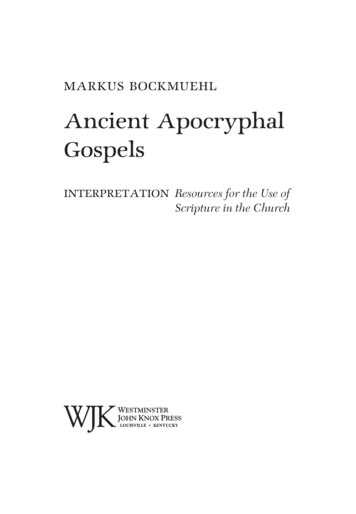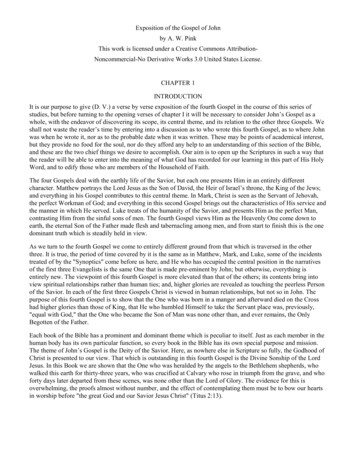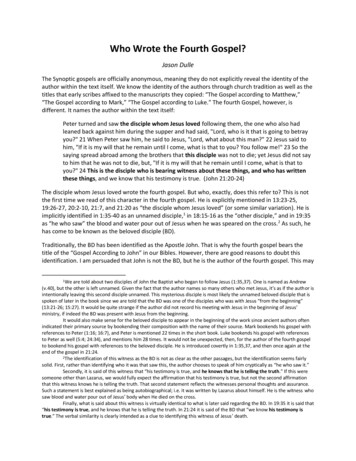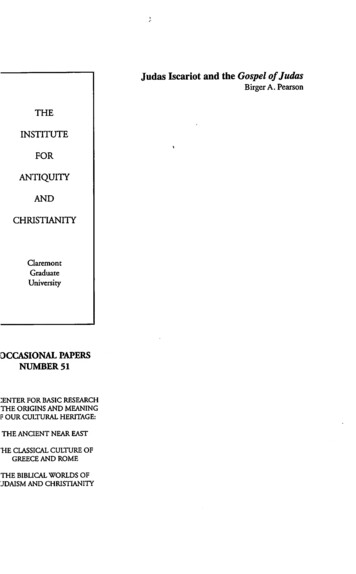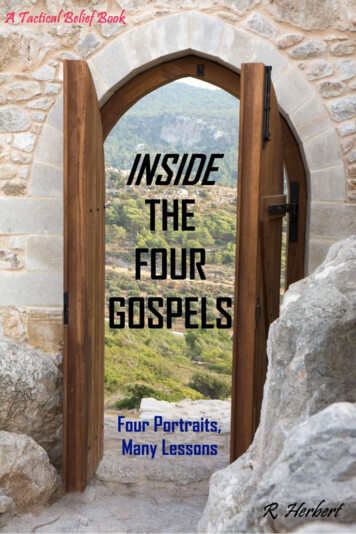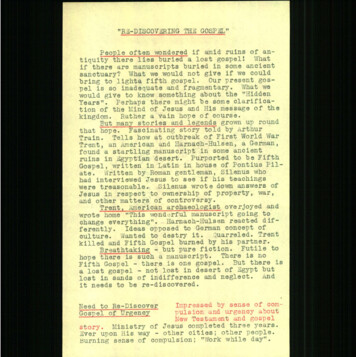
Transcription
THE FOURTH GOSPEL AS REACTION TOMILITANT JEWISH EXPECTATION OFKINGSHIP, REFLECTED IN CERTAIN DEADSEA SCROLLSby Travis Darren Trostin accordance with the requirements of theUniversity of South Africa for the degree of DThin New Testament
Summary ofThe Fourth Gospel As Reaction To Militant Jewish Expectation Of Kingship,Reflected In Certain Dead Sea ScrollsThe discovery of the Dead Sea Scrolls has provided an opportunity to reexaminethe formation of the Gospel of John. This study will utilize Dead Sea finds coupled withother Second Temple literature to examine how the Gospel of John portrays Jesus asbeing a king. The approach of this study to use a narrative approach that builds on theGospel of John as a finished text. The contribution of a source critical approach is notdisparaged but the narrative approach will allow the Johannine community to be seen inthe context of the immediate post-Second Temple era. The limited literacy of theprobable first audience of this text suggests that a narrative approach will best be able tounderstand the background to the formation of the Gospel of John.A central contention of this study is that the Gospel of John was composed afterthe Jewish Revolt and after the Synoptics. Thus it deserves the appellation of the FourthGospel and is called such in this study. The Fourth Gospel was composed at a time whenRoman interest in anything connected to Judaism was sure to attract special interest.Thus the portrayal of Jesus as the Davidic Messiah needed to be handled carefully. Theimagery of the new David found in 4Q504 compared with the imagery of Jesus being theGood Shepherd becomes an important part of the argument of this study on whether thisGospel portrays Jesus as being the Davidic Messiah. Jesus as the Good Shepherd showedJews that Jesus is the Davidic Messiah without overtly offending Roman sensibilities.Furthermore evidence from Christian and Jewish sources indicates that an interest in aThird Temple was still stirring between the Jewish and Bar-Kochba Revolts. The FourthGospel shows Jesus as the Davidic Messiah who replaces the Temple because the GoodShepherd was the perfect sacrifice.Key terms : Messiah; Second Temple Judaism; the Qumran community; theJohannine community; the Fourth Gospel; the term λÛστÐv (bandit); the new David;shepherd; Flavian dynasty; Josephus.
KeyDead Sea ScrollsCD, CD-A, and CD-BDamascus Document1QSThe Rule of the Community1QMWar Scroll1Q341QFestival Prayers2Q4, 4Q554, 4Q555, 5Q15, and 11Q18New Jerusalem Texts4QMMTHalakhic Letter4Q1614QIsaiah Pesher a4Q1744QFlorilegium4Q252, 4Q253, 4Q254, and 4Q254 aGenesis Peshers4Q2854QWar Scroll g4Q3854QPseudo-Ezekiel4Q3864QPseudo-Ezekiel b4Q400, 4Q401, 4Q402, 4Q403, 4Q404, 4Q405, and 11Q17 Songs of the SabbathSacrifice4Q4484QApocryphal Psalm andPrayer4Q5044QWords of the Luminaries4Q5084QFestival Prayers b4Q5214QMessianic Apocalypse11Q19 and 11Q20Temple ScrollNon-Dead Sea Scroll Sources2 Bar.2 Baruch4 EzraAnn. and His.(Tacitus )Annals and Histories
Ant. and J.W.Antiquities and Jewish War(Josephus)Apocr. Ezek.Apocryphon of EzekielDom., Nero and Vesp.Domitian, Nero, andVespasian in the Twelve Caesars (Suetonius)Ep. Barn.Epistle of BarnabasEp. Tra.Epistle to Trajan (Pliny)His.Histories (Cassius Dio)Hist. eccl.Historia Ecclesia (ChurchHistory) (Eusebius)Jub.JubileesPss. Sol.Psalms of SolomonShepherd of HermasShepherd of HermasSib. Or.Jewish Sibylline Oraclesy. Ta’anitPalestinian TalmudMiscellaneousANEAncient Near EastLXXSeptuagintSPSamaritan PentateuchMTMasoretic Text
Table of ContentsTitle PageSummaryKeyTable of ContentsiiiiiivChapter One: 1.131.141.151.161.171.18The Study of the Gospel of JohnThe Fourth GospelJohn, Sources, the Synoptics, and OriginsThe Fourth Gospel, the Synoptics, and DependencyPostcolonialismPostcolonial Perspectives and New Testament StudiesLiterary Unity of the Fourth GospelThe Question of a Female SourceLetting the Narrative FlowThe Need for Narrative CriticismAuthorshipThe Development of TextsPrivilege and LiteracyThe Burden of LibrariesOral ReadingsThe Importance of Orality to the Fourth GospelRhetoric, Propaganda, and OralityMethodological Approach1257911131416192124252627282829Chapter Two: The Dead Sea Scrolls and the Hope for a Future 42.15IntroductionQumran CommunityThe Importance of the Dead Sea ScrollsTwo Messiahs4QMMT Interpretation and David4QMMT and Hebrew BibleSummary of 4QMMTKing and Cult4Q174 and the New DavidThe Genesis Peshers and 4Q252Samuel and a Model KingHellenistic Treatises and the Statutes of the KingSynopsis of the Temple ScrollThe Context of the Statutes of the KingThe Temple Scroll and the Damascus Document323335353739414243454647484951
282.292.302.312.322.332.342.352.362.37Palace GuardThe Body GuardEzekiel and the Temple ScrollSummary of the Temple ScrollThe War ScrollIsaiah Peshers and 4Q285War Scroll and Temple ScrollImplications of a Royal MessiahAthronges the Shepherd PretenderShepherd Imagery and QumranWords of the Luminaries1Q34 Festival PrayerShepherd, Zechariah, and the Damascus DocumentImplications for the Qumran Community on Davidic KingshipQumran’s Royal MessiahSongs of the Sabbath SacrificeDivine WarriorTextual Synopsis of the Songs of the Sabbath SacrificeSummary to the Songs of the Sabbath SacrificeCommon Qumran ThemesExegesis at Qumran and in the New TestamentConclusion: The Qumran Impact on the Fourth Chapter Three: The Complexity of Messianic Politics and the Fourth .143.153.163.173.183.19IntroductionExclusiveness and Late Second Temple JudaismMoses and the Fourth GospelThe Authority of Hebrew Scripture in the Fourth GospelThe Focus on the Messiah within the Fourth GospelOne Man to Die for the NationThe Titulus and Written Communication in the Fourth GospelLiteracy and Social Marginalization for the Fourth GospelJohn the Baptist and an Independent TraditionThe Death of John the BaptistMachaerusJohn the Baptist and Possible Qumran Connect ionsThe FellingThe Fourth Gospel and 2 BaruchJohn the Baptist and RevolutionIrony: Is Jesus from David and Bethlehem?Rome and DavidDomitian as Lord and MasterConclusion: The Need for Carefulness in the Fourth 115
Chapter Four: The Roman Interest in Jewish 134.144.154.164.174.18IntroductionKingship and the Scrolls1 Maccabees, the Hasmoneans, Torah, and QumranHerod the Great and LegitimacySecond Temple OverviewImplicatons of the Dating of the Fourth GospelThe Rise of the Flavian DynastyIf the Rebels Had Won Roman History and Politics as PropagandaRome and SourcesGalilean IdentificationA Possible Militant Disciple in the GospelsA King by Force or NotPaul and the Royal MessiahNero, Christianity, and the Fire at RomeRome, Victory, and Temples after the Jewish RevoltMessianic Expectations between 70 and 130 CEConclusion: Fourth Gospel and Roman 138141142143Chapter Five: The Good Shepherd and the .145.155.165.175.185.195.205.21IntroductionThe Emotional Connection of the Temple to Jewish LifeThe Sanctuary at Mt. ZionThe Samaritan WomanSamaritan HistoryJosephus and the SamaritansJosephus as a ManThe Temple C leansing and the Good ShepherdEzekiel and the New DavidJeremiah, Faulty Shepherds, and the Good ShepherdThe Role of ZechariahThe Role of I Enoch and Shepherd ImageryMatthew and the Lost Sheep of IsraelJohn 10 and the Good ShepherdThe Other SheepBarabbasThe Good Shepherd and BarabbasThe Shepherd of HermasThe Apocryphon of EzekielFourth Ezra, the Shepherd, and the 3164165168169172174176178180
Chapter Six: The Johannine Community in the Post 70 CE 146.156.166.176.186.196.20IntroductionRuler of the WorldJosephus and the Second TempleQumran Eschatology and the Jewish Revolt4Q252 and Eschatological AmalekThe Eschatological Perspective of the GospelsKingdom of God in the Fourth GospelVespasian as World RulerTitus and BereniceNero and the EastJewish Christianity and the Jewish RevoltEphesus, the Roman Empire, and ProvenanceThe Fourth Gospel and the Possibility of Imperial InformersPliny the Younger’s Letter to Trajan on ChristiansTrajan’s ResponseBirkat Haminim and the Eighteen BenedictionsSynagogue, Persecution, and the Eighteen BenedictionsThe Eighteen Benedictions, Heretics, and the Arrogant KingdomPolitics and the Eighteen BenedictionsConclusion: The Center of Christianity in c.100 208209210212Chapter Seven: The Temple after 70 .157.16IntroductionThe Third TempleThe Temple as FortressLeontopolisThe Absence of the Destruction of the TempleTemple DesecrationHebrews, the Temple, and the Fourth GospelEpistle of BarnabasRabban Yohanan ben ZakkaiThe Sibylline Oracles and the Man with the Sceptre4Q521The Synoptic Connection, 4Q521, and the Fourth GospelThe Temple and Bar-KochbaNew Jerusalem TextsRevelation, David, and the Fourth GospelConclusion: Implications of the Hope for a Third 0243
Chapter Eight: Final Conclusion8.18.28.38.48.58.68.78.8What If?The Audience and the NarrativeJewish Milieu of Early ChristianityThe Jewish Revolt and the Next EraWhat is a Davidic Messiah?The Place of the Temple in the Fourth GospelThe Challenge of a Third TempleFinal ial Note: The pagination of the Table of Contents reflects the paperversions of the dissertation. The electronic version is somewhat different due to thecompilation of the entire dissertation into one document.
Chapter One: Methodology1.1 The Study of the Gospel of JohnThe Gospel of John provides both one of the greatest opportunities andconundrums in the study of early Christianity. Its high christology and its focus on theuniqueness of Jesus has made it a favorite text of those who have sought to understandearly Christianity as a message of hope to a lost world. Conversely the high christologyof the Gospel of John has raised questions whether such a christology is a communitycreation or a product of the most primitive tradition. Culpepper’s statement that this text“is paradoxically both the most and the least historical of the four Gospels”1 illustratesone of the challenges facing any critical study of the Gospel of John. While there will bedisagreement with Culpepper’s statement, it does highlight the tension facing any seriousstudy of the Gospel of John.The whole debate of whether the Gospel of John is a product of Hellenistic orGnostic influences has raised questions concerning the origins of this text. 2 Indeed thevery uniqueness of the Gospel of John in comparison to the Synoptics has raised the issueof what tradition is represented by the Gospel of John. A fundamental question thatdeserves to be asked about the nature of the Gospel of John is: Why? What purpose doesthe Gospel of John have that the Synoptics do not answer? At times it seems there aremore questions than answers in the study of the Gospel of John but relatively recentevents have given scholarship an opportunity to attack these questions from a differentpoint of view.The discovery of the Dead Sea Scrolls has provided a means of shedding new lighton old questions. Since the emergence of these texts in the years following the SecondWorld War a whole new world has been thrown out to contemporary scholarship.Certainly at least since the publication of John and Qumran in 19723 the topic of howthe Scrolls and the Gospel of John relate has been a significant subject in the field ofJohannine studies. The full impact of the Qumran discoveries has yet to be felt because ofthe long and difficult history of the recovery, translation, and publication of the material1R. Allan Culpepper, The Gospel and Letters of John (Nashville: Abingdon Press, 1998), 13.Seán P. Kealy, John’s Gospel and the History of Biblical Interpretation (2 vols.; Lewiston, New York:Mellen Biblical Press, 2002), 19.3James H. Charlesworth, ed., John and Qumran (London: Geoffrey Chapman Publishers, 1972).21
found in the desert near Qumran. This study seeks to help in repairing this deficit throughthe use of Qumran material that could provide definite insight into the nature of theformation of the Gospel of John. Indeed the suggestion by Ashton that this text waswritten by an Essene 4 has pushed this discussion dramatically forward. Other sources ofinformation both Jewish and Roman that bear on the Second Temple era and its aftermathwill not be ignored but the Qumran community provides the starting point forcomparisons to the Gospel of John for this study.This study will focus on an aspect of messianic expectations in the first centuryCE. Certainly since the publication of Jesus and the Dead Sea Scrolls 5 the question ofhow the Scrolls affect the study of the Historical Jesus has gained further momentum.The thesis of this study is designed to build on that momentum. The state of messianicconsciousness in late Second Temple Judaism is not a simple matter to decipher and itdeserves further examination. What this study will attempt to answer is a specificquestion. What does the Gospel of John say about Jesus being the Da vidic Messiah incomparison to Qumran expectations of a Davidic Messiah in the historical context of theera between the Jewish and Bar-Kochba Revolts?1.2 The Fourth GospelOne of the rare instances in New Testament scholarship in which ancient andcontemporary opinion is united on a historical-critical issue is the question of the latepriority of the Gospel of John. Both the early patristic fathers and a large majority ofhistorical-critical opinion are agreed that the Gospel of John is fourth in priority. Whilethe basis for this agreement is based on different rationales, the significance of this pointshould be noted.The evidence from the ancient world comes in two types. Firstly the tradition ofthe Gospel of John being fourth is summarized by Eusebius (Eusebius, Hist. eccl. 3.24) inhis detailed discussion of the backgrounds of all four Gospels. His detailed explanationof the need for another Gospel in addition to the Synoptics suggests that even at arelatively early date questions were being raised about the Gospel of John. Neverthelessthe tenacity of Eusebius in his defense of the Gospel of John being fourth in priority45John Ashton, Understanding the Fourth Gospel (Oxford: Clarendon Press, 1991), 237.James H. Charlesworth, ed., Jesus and the Dead Sea Scrolls (New York and London: Doubleday, 1992).2
indicates the importance of the tradition to him. Secondly the canonical order of theGospels in the arrangement of the New Testament is also evidence for an expectation thatthe Gospel of John was the Fourth Gospel. Luke is separated from Acts by the Gospel ofJohn and this again suggests that the Gospel of John was viewed as comingchronologically after Luke. Luke-Acts as a single work would make sense from a strictlyliterary standpoint but the insertion of the Gospel of John between these two worksindicates that a compelling reason motivated the church to divide them.From the standpoint of critical scholarship the same conclusion has been reachedalbeit using a different methodology. It is generally agreed that the Synoptics precededthe Gospel of John in terms of both composition and distribution and that the Gospel ofJohn is the Fourth Gospel. There is rough agreement on the date of the writing of theGospel of John between c. 90 CE to c. 100 CE. Indeed Robinson in his challenge of theconventional date for the Gospel of John states, “The span 90-100 is agreed by Catholicand Protestant, by conservative and radical, by those who defend apostolic authorship andthose who reject it, by those who believe that John used the synoptists and those who donot.”6 This makes the dating and late priority of the Gospel of John an almost uniquephenomenon in New Testament scholar ship. Authorities from widely divergent worldsagree on a critical issue.Even though there a few dissenters7 in contemporary academia who argue forthe Gospel of John being written before one or more of the Synoptics, majority opinion isstrongly in favo r of the Gospel of John coming later than the Synoptics. This is animportant consideration. Scholars as diverse as Carson and Bultmann would both admitthat the Gospel of John was written later than the Synoptics when there is little else theywould hold in common. This near unanimous agreement provides an optimal startingpoint to engage the issues related to the composition of the Gospel of John, the FourthGospel. 8 This agreement provides the widest possible basis to conduct a study of theFourth Gospel with hopefully the greatest respect for the contributions from all eras andmethodologies.6John A.T. Robinson, Redating the New Testament (Philadelphia: The Westminster Press, 1976), 261.John A.T Robinson is perhaps the most famous of the exponents of the pre -70 CE date.8Hereafter the Gospel of John will be described as the Fourth Gospel.73
While the dating of the Gospel of John has achieved a near unanimousplacement near the end of the first century CE, the dating of the Synoptics is widelyscattered. Dating Mark and Q to before the destruction of the Temple in 70 CE would notbe controversial though many would date Mark after the Jewish Revolt. Dating Matthewand Luke before the Jewish Revolt would be a minority opinion in the minds of mostcritical scholars. A date in the decade after the Jewish Revolt for Matthew and Lukewould be a popular position. Nevertheless even if all the Synoptics are dated to thedecade after the Jewish Revolt, the dating of Q before the Jewish Revolt is a highprobability. Thus Matthew and Luke would be written from at least one source that waspre-Revolt. It is even possible to argue that one or more of the Synoptics was publishedduring the Jewish Revolt when the conflict was still to be determined. Thus the Synopticsshould be viewed as being written with a focus on the Jewish Revolt as a future orcontemporary event regardless of whether they were published before or after the JewishRevolt. 9The impact of the Synoptics on the post-70 CE world comes from theirexpression of the generation that predates the Jewish Revolt. The treatment of thedestruction of the Temple in Mk 13, Mt 24, and Lk 21 is given a future sense but in theFourth Gospel this apocalyptic discourse is not part of the Fourth Gospel. 10 Thus for thepurposes of this study the Synoptics will be viewed as being published before the Gospelof John and as being rooted in the social situation of pre-Revolt Jewish Palestine. TheFourth Gospel relates events in Jesus’ life before the Jewish Revolt from the perspectiveof a post-70 CE composition. The Fourth Gospel belongs to the generation after theJewish Revolt and needs to be treated as such.9If Q was a written source, when was it compiled? Was it compiled before the Jewish Revolt or after it? Ifafter it, than why compile a source when the Go spels of Matthew and Luke will be soon written? If oneargues that Matthew and Luke should be viewed as reflecting the post-70 CE era, one needs to answer thisquestion. If one abandons the Two Source Theory of Synoptic origins, than one does not have to accountfor Q. That being said a large majority of critical scholarship is not prepared to go down this route. If Q isviewed as an oral source, its dating becomes even harder to track. This study is not an attempt to date Q butthe point made in the body o f this text still stands. Assuming a post-70 CE date for Matthew and Luke doesnot mean Q is a post-70 CE source.10The topic of the destruction of the Second Temple will be treated in more depth later in this study.4
1.3 John, Sources, the Synoptics, and OriginsIn the study of the Fourth Gospel great attention has been paid to the question ofperceived sources behind the Fourth Gospel, its relation to the Synoptic Gospels, and thecultural milieu in which it was formed. Indeed the search for the sources and theredaction of sources that are believed to be behind the Fourth Gospel has played a veryinfluential part of the analysis of this text. Certainly there is reason to view the FourthGospel as having multiple sources. The use of the plural verb form “we know”(o¹damen) in Jn 21:24 provides the greatest evidence that there is more than one personresponsible for publishing/distributing the Fourth Gospel. This approach gives thestrongest interpretive value to the use of the plural. 11 It is also the most natural readingof the text. If it is assumed that the use of the plural is an editorial device that is a selfreference to one individual, 12 the whole question of how grammar should be understoodin the Fourth Gospel becomes quite subjective.The better interpretation is to take the text at face value. The Fourth Gospel of itsown volition suggests quite strongly that more than one source was behind it and thisadmission should be respected. Jn 21:24 clearly gives credit to the Beloved Disciple asbeing the literary mastermind for the Fourth Gospel and it suggests a modest role for afollower(s) who finished Jn 21. The question emerges next as to what should be donewith this knowledge.Several approaches are notable for their influence on the shape of Fourth Gospelstudies in their approaches to sources. Bultmann’s theory of the formation of the FourthGospel involved a revelation-discourse source that helped shape portions of the FourthGospel like the Prologue 13 and a signs source that was used for the miracles 14 that wereused by a redactor to shape the final product. Furthermore according to Bultmann thePassion account in the Fourth Gospel relies on a source that displays unity in both styleand language 15 but is distinct from the others.While Bultmann was interested in exploring the relationship of the Fourth Gospelwith Gnosticism others had different concerns. Dodd’s approach rested on a search for a11D.A. Carson, The Gospel According to John (Grand Rapids: Eerdmans, 1991), 683.Carson, John, 684.13Rudolf Bultmann, The Gospel of John (trans. G.R. Beasley-Murray; Oxford: Basil Blackwell, 1971), 16.14Bultmann, Gospel of John, 113.15Bultmann, Gospel of John, 635.125
historical tradition that relied on an “original Aramaic tradition” 16 and that condensedmaterial from this larger tradition. 17 Dodd was interested in demonstrating that theprimary source behind the Fourth Gospel was independent of the Synoptics. Brown onthe other hand was interested in drawing opinions from both the German and Britishtraditions and using it in his own work. Brown allowed for five stages of development18of the text that includes more than one editor and may have included oral tradition. 19Brown’s perspective as a Roman Catholic and an American did not stop him fromutilizing Protestant scholarship from Europe to develop his own theory of sources for theFour th Gospel.These sketches are not meant to be exhaustive of the positions of these men or ofthe current debate but they each represent an analysis of the Fourth Gospel that isdependent on understanding the perceived sources that underline it and each hasinfluenced the generation of scholarship that read their work. On this issue two importantconsiderations deserve to be made. Firstly while there are points of agreement betweenthe various solutions, the differences of the solutions offered point to the inherentdifficulty of isolating sources for a text like the Fourth Gospel. While evidence for aBook of Signs can be brought forth, reconstructing the hypothetical Book of Signs is anuncertain task. The depth of consensus seen in the dating of the Fourth Gospel and in itslate priority is not seen in reconstructing the sources behind the Fourth Gospel.Secondly the focus on comparing the Fourth Gospel with the Synoptics needs tobe done in light of the discoveries of the Dead Sea Scrolls. The impact of GardnerSmith’s book, St. John and the Synoptic Gospels, first published in 1938 has proved to bevery influential in reshaping the debate concerning whether it was dependent on theSynoptics are not. His work challenged the consensus of scholarship from the ancientworld until the modern that the Fourth Gospel was dependent on the Synoptics. Hesucceeded in turning a considerable body of critical scholarly opinion into concludingthat the Fourth Gospel was independent of the Synoptic literary traditio n. Yet GardnerSmith’s triumph was not as conclusive as first thought.16C.H. Dodd, The Historical Tradition in the Fourth Gospel (Cambridge: Cambridge University Press,1976), 424.17Dodd, The Historical Tradition, 429.18Brown, The Gospel According to John (2 vols.; New York: Doubleday, 1966), xlix.19Brown, John, xxxv.6
1.4 The Fourth Gospel, the Synoptics, and DependencyIf one is looking for a consensus on the question of the Fourth Gospel’s relationshipwith the Synoptics today, prepare to be disappointed. Keener in his recent commentaryon the Fourth Gospel outlines several positions that have attracted support. Firstly theFourth Gospel used Matthew. Secondly the Fourth Gospel used Luke. Thirdly the FourthGospel used Mark. 20 Keener rates option 1 (Matthew) as being the least popular. Luke isthe next choice in popularity and Mark the most popular option for scholars who seesome link with the Fourth Gospel. 21 The important issue to note is that these arepositions taken by scholars who see a connection with the Fourth Gospel. Keener alsonotes the common view that the agreements between Luke and the Fourth Gospel areminor and not the result of direct dependence. 22 Thus the position that the Fourth Gospelis not dependent on a Synoptic tradition is well represented. A trickier question is theissue of indirect dependence. Some scholars see other indirect sources of tradition whichmay have been available to the Fourth Gospel without direct dependence on theSynoptics. 23 These competing positions outline again the challenge of achievingconsensus on the question of sources. A few examples of these positions are worthgiving.Gardner-Smith’s consensus has again been challenged with arguments forsignificant Synoptic influence from scholars like Fortna 24 who see significant influenceon the Fourth Gospel from the Synoptics. Brown highlights the difficulty of this problemin his analysis of the parable of the multiplication of the loaves common to all fourGospels in which he lists scholars like Mendner arguing for dependence on the Synopticsand others like Dodd arguing for Johannine independence.25 Brown’s conclusion is thatthe Johannine account is independent of the Synoptics but he allows for the possibilitythat the final redactor of the Fourth Gospel supplied details from Mark. 26 For a scholar as20Craig S. Keener, The Gosp el of John A Commentary (2 vols.; Peabody, Mass.: Hendrickson Publishers,2003, 40.21Keener, The Gospel of John A Commentary, 40.22Keener, The Gospel of John A Commentary, 40.23Keener, The Gospel of John A Commentary, 40. Keener provides an admirable catalogue of the variouspositions in brief, succinct form and then proceeds to provide his opinion of the evidence.24Robert I. Fortna, “Jesus Tradition in the Signs Gospel,” in Jesus in Johannine Tradition (eds. Robert T.Fortna and Tom Thatcher; Louisville: Westminster John Knox Press, 2001), 200.25Brown, John, 236.26Brown, John, 244.7
gifted as Brown to provide such a roundabout conclusion crystallizes the importance ofanalyzing the Fourth Gospel in terms that are not captive to theories of literarydependence. Weighing the difference betwee n direct and indirect dependence becomes amurky issue and establishing a boundary between the two seems quite difficult. If Q wasavailable to the narrator of the Fourth Gospel, what does that say about Matthew’s andLuke’s use of Q? What about Mark’s relationship with the other Synoptics and/or theFourth Gospel? Brown’s ambivalence on the issue of sources illustrates the challenge offinding agreement on the sources behind the Fourth Gospel.Even if it is assumed that the Fourth Gospel is independent of the Synoptics, thequestion of whether it could ignore the Synoptics is another question. Could the circleresponsible for the Fourth Gospel live independent of all influences from other branchesof Christianity? Gardner-Smith first wrote his work in 1938 and he did not have thebenefit of the discovery of the Dead Sea Scrolls to place a broader context on his work.The world of late Second Temple Judaism was one in which communication between themovements responsible for the texts found near Qumran and other groups like the earlyJesus movement now seem possible. If Ashton’s suggestion is correct that the FourthGospel comes from an Essene, the relationship between the Fourth Gospel and Qumranliterature potentially becomes much tighter. 27 From the perspective of first century CEJudaism and Christianity a relationship between Jewish Christian texts and Jewish textsmay seem plausible. Questions that would seem outlandish from a pre-World War IIperspective are in the third millennia much more credible than anyone of an earlier eracould imagine.Viewing the Fourth Gospel as an independent literary source is a viable approach;viewing it as independent of the world of the Synoptics and of late Second TempleJudaism in the light of the discoveries made since 1947 is problematic. Keener’scomment that “suggesting that the Fourth Gospel is not directly dependent on theSynoptics need not imply that John did not know of the existence of the Synoptics”28 is27This study does not argue for such a link but Ashton’s sug
Reflected In Certain Dead Sea Scrolls The discovery of the Dead Sea Scrolls has provided an opportunity to reexamine the formation of the Gospel of John. This study will utilize Dead Sea finds coupled with other Second Temple literature to examine how the Gospel of John portrays Jesus as being a king.




